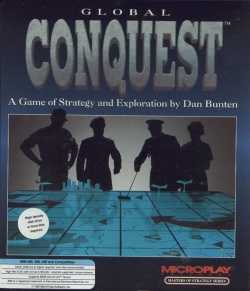Global Conquest
| Global Conquest | |
|---|---|
 Cover art | |
| Developer(s) | Ozark Softscape |
| Publisher(s) | Microplay Software |
| Designer(s) | Danielle Bunten Berry |
| Composer(s) | David Warhol |
| Platform(s) | MS-DOS |
| Release date(s) |
|
| Genre(s) | Strategy |
| Mode(s) | Multiplayer |
| Distribution | Floppy disk(s) |
Global Conquest is a computer game developed by Microplay Software in 1992 for the PC/MS-DOS.
Plot
Global Conquest is a strategy game where the object is to discover territories and conquer the world through strategy and management of military and economic resources.
The game always involves four opponents, which may be controlled by the computer or human players, and can be played via modem. The world is generated for every game, with the environment composed of oceans, plains, forests, swamps, or mountains, to which the players add units such as infantry, armor, subs, airplanes, battleships, and aircraft carriers. Players start with, and can manufacture, a spy unit that can not only steal secrets but can see with wide-ranging eyes. A player's Comcen is the most powerful piece, and a player is out of the game upon losing the Comcen. A player's collection of cities, also known as burbs, creates units and must then financially support them with money dumped into the treasury each turn.[1]
Reception
The game was reviewed in 1993 in Dragon #189 by Hartley, Patricia, and Kirk Lesser in "The Role of Computers" column. The reviewers gave the game 4 out of 5 stars.[1]
Multiplayer
The game is playable over the internet by a variety of methods. The player can use DOS Box to connect to other players to play using an IPX driver. It is also possible to connect up to three computers to a fourth master computer using null modem cables (assuming the master computer has enough serial ports), allowing for four human's to play. Tunneling is another method which allows at least two-way play. There is a fan Facebook page (search for Global Conquest).
References
External links
- Global Conquest at MobyGames
- Global Conquest at Allgame
- Global Conquest at IGN
- Global Conquest at GameSpy
- Global Conquest at GameFAQs